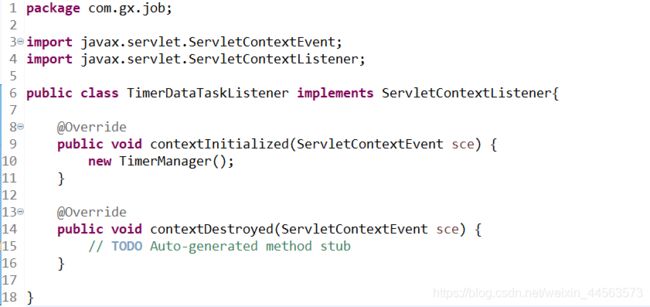Java Web项目之添加定时任务
文章目录
- 一、使用监听器注入
- (1)创建监听器类:(示例代码)
- (2)创建定时任务类:(示例代码)
- (3)创建TimerTask类:(示例代码)
- (4)在web.xml注册监听器:(示例代码)
- 二、使用spring注解注入
- (1)在SpringMVC配置文件(applicationContext.xml)中添加
- (2)示例Demo:
- (3)注意事项:
- (4)扩展:定时时间的设置
- (5)通配符说明:
在Java Web程序中加入定时任务,这里介绍两种方式:1.使用监听器注入;2.使用Spring注解@Scheduled注入。
推荐使用第二种形式。
一、使用监听器注入
(1)创建监听器类:(示例代码)
package com.gx.job;
import javax.servlet.ServletContextEvent;
import javax.servlet.ServletContextListener;
public class TimerDataTaskListener implements ServletContextListener{
@Override
public void contextInitialized(ServletContextEvent sce) {
new TimerManager();
}
@Override
public void contextDestroyed(ServletContextEvent sce) {
// TODO Auto-generated method stub
}
}
(2)创建定时任务类:(示例代码)
package com.gx.job;
import java.util.Calendar;
import java.util.Date;
import java.util.Timer;
public class TimerManager {
// 时间间隔:24h
private static final long PERIOD_DAY = 24 * 60 * 60 * 1000;
public TimerManager() {
Calendar calendar = Calendar.getInstance();
// 定制每日12:30:30执行
calendar.set(Calendar.HOUR_OF_DAY, 12);
calendar.set(Calendar.MINUTE, 30);
calendar.set(Calendar.SECOND, 30);
Date date = calendar.getTime(); // 第一次执行定时任务的时间
// 如果当前时间已经过去所定时的时间点,则在第二天时间点开始执行
if (date.before(new Date())) {
date = this.addDay(date, 1);
}
Timer timer = new Timer();
TimerTaskService task = new TimerTaskService();
// 安排指定的任务在指定的时间开始进行重复的固定延迟执行。
timer.schedule(task, date, PERIOD_DAY);
}
// 增加或减少天数
private Date addDay(Date date, int num) {
Calendar startDT = Calendar.getInstance();
startDT.setTime(date);
startDT.add(Calendar.DAY_OF_MONTH, num);
return startDT.getTime();
}
}
(3)创建TimerTask类:(示例代码)
package com.gx.job;
import java.util.TimerTask;
public class TimerTaskService extends TimerTask {
@Override
public void run() {
try {
// 要执行的任务逻辑写在这里
System.out.println("执行成功");
} catch (Exception e) {
System.out.println("执行失败");
}
}
}
(4)在web.xml注册监听器:(示例代码)
<!-- TimerDataTaskListener 监听器 -->
<listener>
<listener-class>com.gx.job.TimerDataTaskListener</listener-class>
</listener>
二、使用spring注解注入
这里以SSM框架(Spring + SpringMVC + Mybatis)为例:
(1)在SpringMVC配置文件(applicationContext.xml)中添加
xmlns:task="http://www.springframework.org/schema/task"
http://www.springframework.org/schema/task
http://www.springframework.org/schema/task/spring-task-3.2.xsd
然后配置任务扫描:
<task:annotation-driven />
最后配置扫描任务位置
<context:component-scan base-package="com.gx.job"/>
<?xml version="1.0" encoding="UTF-8"?>
<beans
xmlns="http://www.springframework.org/schema/beans"
xmlns:xsi="http://www.w3.org/2001/XMLSchema-instance"
xmlns:p="http://www.springframework.org/schema/p"
xmlns:context="http://www.springframework.org/schema/context"
xmlns:aop="http://www.springframework.org/schema/aop"
xmlns:tx="http://www.springframework.org/schema/tx"
xmlns:task="http://www.springframework.org/schema/task"
xsi:schemaLocation="
http://www.springframework.org/schema/tx
http://www.springframework.org/schema/tx/spring-tx-3.1.xsd
http://www.springframework.org/schema/aop
http://www.springframework.org/schema/aop/spring-aop-3.1.xsd
http://www.springframework.org/schema/context
http://www.springframework.org/schema/context/spring-context-3.1.xsd
http://www.springframework.org/schema/beans
http://www.springframework.org/schema/beans/spring-beans-3.1.xsd
http://www.springframework.org/schema/task
http://www.springframework.org/schema/task/spring-task-3.1.xsd ">
<!-- 开启注解 -->
<context:annotation-config />
<!-- 开启定时任务 -->
<task:annotation-driven/>
<!-- 自动扫描 -->
<context:component-scan base-package="com.gx.job"/>
</beans>
(2)示例Demo:
package com.gx.job;
import org.springframework.scheduling.annotation.Scheduled;
import org.springframework.stereotype.Component;
@Component
public class FlightTrainTask {
@Scheduled(cron = "0/5 * * * * ? ") // 间隔5秒执行
public void taskCycle() {
System.out.println("使用SpringMVC框架配置定时任务");
}
}
(3)注意事项:
1、spring的@Scheduled注解 需要写在实现方法上。
2、 定时器的任务方法不能有返回值。(如果有返回值,spring初始化的时候会告诉你有个错误、需要设定一个proxytargetclass的某个值为true)
3、实现类上要有组件的注解@Component 。
(4)扩展:定时时间的设置
关于定时时间的设置方式如下:
如:“0/5 * * * * ?”
CronTrigger配置完整格式为: [秒] [分] [小时] [日] [月] [周] [年]
参考如下:
| 序号 | 说明 | 是否必填 | 允许填写的值 | 允许的通配符 |
|---|---|---|---|---|
| 1 | 秒 | 是 | 0-59 | , - * / |
| 2 | 分 | 是 | 0-59 | , - * / |
| 3 | 时 | 是 | 0-23 | , - * / |
| 4 | 日 | 是 | 1-31 | , - * ? / L W |
| 5 | 月 | 是 | 1-12或JAN-DEC | , - * / |
| 6 | 周 | 是 | 1-7或SUN-SAT | , - * ? / L W |
| 7 | 年 | 否 | empty或1970-2099 | , - * / |
(5)通配符说明:
* 表示所有值。例如:在分的字段上设置 “*”,表示每一分钟都会触发。
? 表示不指定值。使用的场景为不需要关心当前设置这个字段的值。例如:要在每月的10号触发一个操作,但不关心是周几,所以需要周位置的那个字段设置为"?" 具体设置为 0 0 0 10 * ? 。
- 表示区间。例如:在小时上设置 “10-12”,表示 10,11,12点都会触发。
, 表示指定多个值,例如:在周字段上设置 “MON,WED,FRI” 表示周一,周三和周五触发。
/ 用于递增触发。例如:在秒上面设置"5/15" 表示从5秒开始,每增15秒触发(5,20,35,50)。 在月字段上设置’1/3’所示每月1号开始,每隔三天触发一次。
L 表示最后的意思。在日字段设置上,表示当月的最后一天(依据当前月份,如果是二月还会依据是否是润年[leap]),在周字段上表示星期六,相当于"7"或"SAT"。如果在"L"前加上数字,则表示该数据的最后一个。例如在周字段上设置"6L"这样的格式,则表示“本月最后一个星期五"。
W 表示离指定日期的最近那个工作日(周一至周五)。例如:在日字段上设置"15W",表示离每月15号最近的那个工作日触发。如果15号正好是周六,则找最近的周五(14号)触发,如果15号是周未,则找最近的下周一(16号)触发,如果15号正好在工作日(周一至周五),则就在该天触发。如果指定格式为 “1W”,它则表示每月1号往后最近的工作日触发。如果1号正是周六,则将在3号下周一触发。(注,“W"前只能设置具体的数字,不允许区间”-")。
# 序号(表示每月的第几个周几),例如在周字段上设置"6#3"表示在每月的第三个周六。注意如果指定"#5",正好第五周没有周六,则不会触发该配置(用在母亲节和父亲节再合适不过了) 。
小提示:
'L’和 'W’可以组合使用。如果在日字段上设置"LW",则表示在本月的最后一个工作日触发;
周字段的设置,若使用英文字母是不区分大小写的,即MON 与mon相同。





